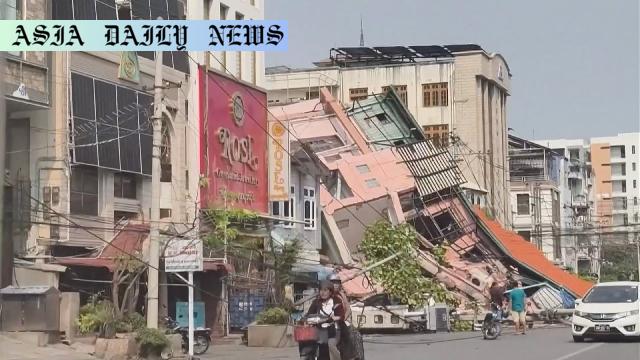Myanmar earthquake research unveils shocking 400-km fault shift and 6-meter slippage along the Sagaing Fault, GSI reports.
- Myanmar’s 7.7 magnitude earthquake caused a 6-meter ground slip on a 400-km fault.
- Japan’s GSI satellite data revealed faults running from Mandalay to Naypyitaw.
- Experts highlight the risk of similar inland faults in Japan.

Myanmar Earthquake: Crustal Movement Unveiled
On Friday, a powerful magnitude 7.7 earthquake shook Myanmar, leaving a lasting impact not just on the lives of those in its vicinity, but also visible changes to the Earth’s crust. According to data from Japan’s Geospatial Information Authority (GSI), a staggering 400-kilometer section along Myanmar’s Sagaing Fault was affected. This major fault runs in a north-south direction, stretching from the north of Mandalay, close to the epicenter, to regions south of Naypyitaw, the country’s capital.
The GSI’s analysis, based on satellite data collected before and after the seismic event, revealed that ground movements on both sides of the fault were substantial. The western side of the fault shifted northward, while the eastern side moved southward, with slippages observed to be as much as six meters. Such pronounced movement along an inland fault is not common, even in the context of global seismic activity. This revelation underscores the massive energy released during the earthquake, which experts claim was more than ten times stronger than the destructive 2016 Kumamoto earthquake in southwestern Japan.
A Rare Occurrence in Fault Activity
Munekane Hiroshi, head of the GSI’s Crustal Deformation Research Division, expressed amazement at the magnitude of the fault’s movement. He highlighted the rarity of slippage spread over such an extensive distance within an active inland fault system. While faults are known for their capacity to release built-up stress, the sheer scale of this event serves as a reminder of the unpredictable and immense power of natural forces.
The implications of such findings are significant, particularly for other tectonic zones worldwide. Munekane has pointed out that Japan itself has similar inland active faults, suggesting the potential for equally dramatic events in other regions. This brings to light the importance of continued monitoring and data analysis to aid in preparation and planning against seismic risks globally.
The Role of Satellite Technology
GSI’s findings stand as a testament to the power of advanced Earth observation satellite technology. By monitoring crustal movements precisely, satellites like those deployed by Japan provide an unmatched view of natural events such as earthquakes. With tools providing before and after comparisons, scientists can better understand the underlying mechanisms of fault dynamics, as well as provide insights necessary for mitigating future disasters.
Such a significant event also raises questions regarding the wider implications of fault displacements of this magnitude. Can such extensive crustal movements trigger aftershocks or secondary events in neighboring fault systems? How can technology and geological understanding shape evacuation measures or safety protocols? These are challenges that require deep data analysis and strong global collaboration in the years to come.
Global and Local Repercussions
For Myanmar, the quake is a grim reminder of the risks that come with living in an earthquake-prone region. The affected areas will now face not just rebuilding efforts but also questions related to infrastructure safety against future seismic activities. Urban planners, engineers, and geologists will need to incorporate fault system risk assessments more stringently to safeguard communities.
The lessons from this earthquake are globally significant, as nations with active fault systems, including Japan, must use this as a learning opportunity to predict, prepare, and mitigate similar occurrences.



Commentary
The Importance of Understanding Fault Dynamics
The revelation from Myanmar’s recent earthquake is a poignant reminder of the immense power of tectonic activity beneath our feet. As the GSI findings show, the slippage of up to six meters along a 400-kilometer section of the Sagaing Fault is both fascinating and catastrophic. Such occurrences offer invaluable insights for geologists and scientists worldwide but also stress the urgency of disaster preparedness in regions sitting on active fault lines.
What makes this event noteworthy is its scale. Observations like this challenge traditional models of how faults behave during seismic events. The findings indicate that seismic activities are not only confined to the trembling moments of an earthquake but are also perpetuated through lasting crustal shifts. This reinforces the need for holistic planning, taking into account both short-term tremors and long-term crustal adjustments.
Highlighting the Role of Technology
Satellite technology has once again demonstrated its pivotal role in understanding these natural occurrences. GSI’s ability to detect and quantify the movements of the Earth with such precision reminds us of the vital role technology plays in advancing seismology. However, this serves as a double-edged sword; while we can now better identify risks, we must also commit to using this knowledge responsibly to shape public policy and disaster mitigation strategies.
Past, Present, and Future Implications
This event should also be a wake-up call for regions like Japan and others sitting on active tectonic plates. Earthquakes might seem like rare, isolated events, but they are part of a much larger, interconnected structural dynamic of the Earth. Proactive measures—such as reinforcing buildings, planning effective evacuation routes, and ensuring timely public information dissemination—must be prioritized to minimize future losses.
Understanding earthquakes, their aftermath, and how they shape our planet not only enhances our survival strategies but also deepens our appreciation of the Earth’s complex and dynamic systems. As Myanmar rebuilds, the lessons learned from this earthquake will serve not just the country but the world at large, urging international collaboration and preparedness against nature’s unpredictable power.